Being spring here in South Africa, many creatures have already been a-courting and are turning to nest building or are in the process of brooding their young.
Last week’s post highlighted the increased activity of Egyptian geese and I mentioned how these geese may harass nesting birds such as black sparrowhawks with a view to evicting them and taking over their nests.
Egyptian geese evicting black sparrowhawks from their nests has been documented by researchers working in the Cape Peninsular. For more information and photographs of geese evicting nesting sparrowhawks and occupying nests see here and here.
Interestingly black sparrowhawks that have experienced being evicted from their nests by Egyptian geese have developed strategies that include building multiple nests and breeding earlier in the season (Foote 2016).

A pair of Egyptian geese. These geese are not in our garden – I photographed them at Nsumo Pan at Mkhuze Game Reserve in KwaZulu-Natal
In previous years black sparrowhawks have nested in a tall eucalyptus tree on the margins of the commercial plantation behind our garden. In some breeding seasons we witnessed something like open warfare between Egyptian geese noisily attacking the nesting pair and the black sparrowhawks fighting back in defence of their nest. In each season the black sparrowhawks managed to prevail and went on to raise their young.
Unfortunately though, the last time the black sparrowhawks used their breeding tree they had other problems in the form of tree felling going on all around them, as documented in an earlier post here.
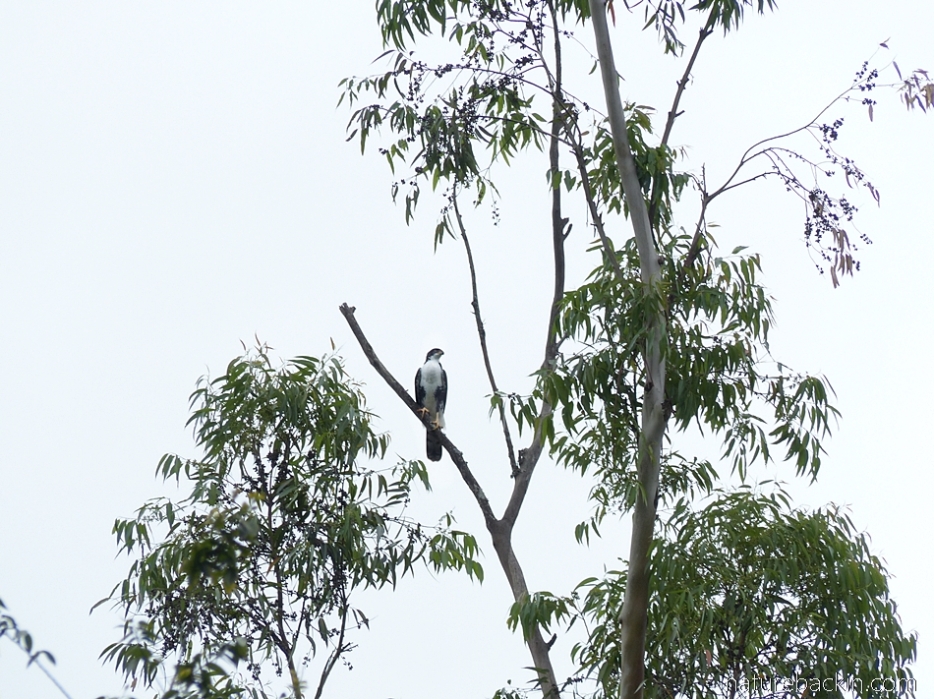
A female black sparrowhawk photographed in July this year, perching in a nearby eucalyptus tree, which is about 80 m from the nesting tree
Although, as explained in the previous post on sparrowhawks, I managed to intervene to stop their nesting tree from being felled, and the female stayed on to raise one chick, the male disappeared during all the disruption and noise of chainsaws and falling trees, and in subsequent years the nesting tree has not been used, not even by Egyptian geese.
However, each year since then, in mid-winter, a female has arrived and remained a few days, often perching in a nearby tree calling loudly. One year a visiting female even teamed up with a mate and although they commenced nest building they too soon disappeared from the neighbourhood.
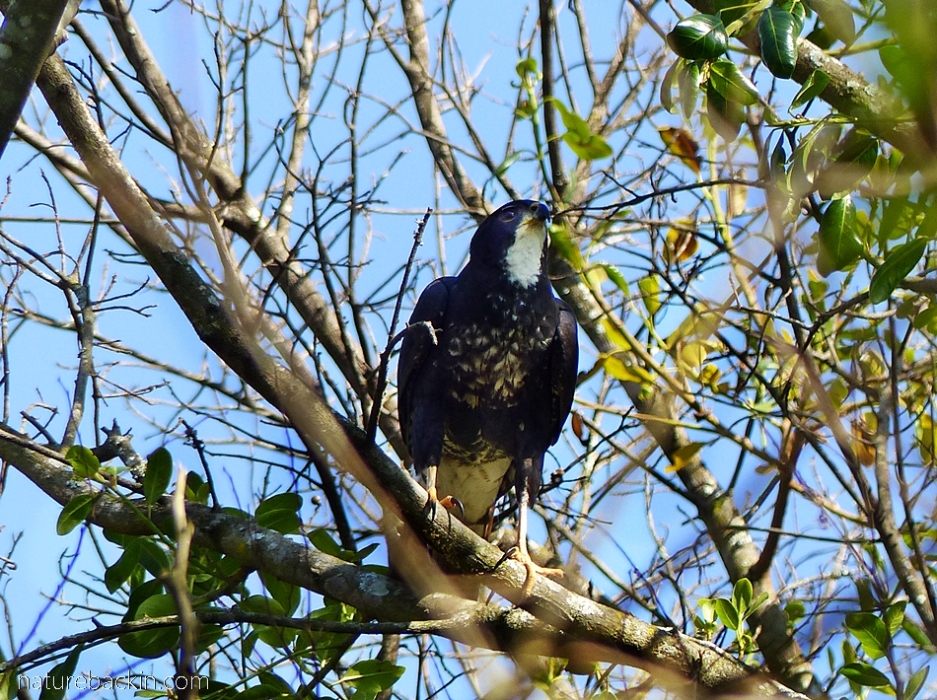
Photographed in September 2014, a male black sparrowhawk, a dark morph variant, in a tree in our garden. For reasons unknown to us, he and his mate abandoned their nest building and disappeared from the neighbourhood
But this winter a female appeared again and then two other sparrowhawks were seen flying around, which we guessed were skirmishing males. She picked a mate, and one day I even saw them mating (see video below). The pair remained in the neighbourhood, calling their distinctive ‘teddy bear’ call often and they built a nest in the same nesting tree used years before, but in a higher fork of branches against the main stem, starting from scratch as the old nest had disintegrated.
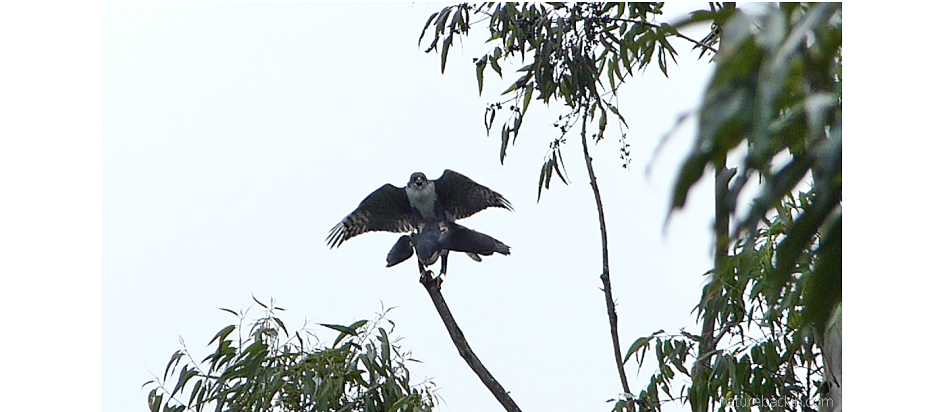
A still from the video of the pair of black sparrowhawks mating in July this year
All seemed to be going well, and a few weeks ago from a distance I could just make out the shape of a chick in the nest. The chick being pure white and about the size of domestic hen was visible from a distance if it stood up near the edge of the nest, but it was too far for a photograph. When closer it is impossible to see into the nest because of the surrounding foliage and its height from the ground. We often saw the parents coming and going from the nest, and although they were not as vocal as before, we heard them calling from time to time.
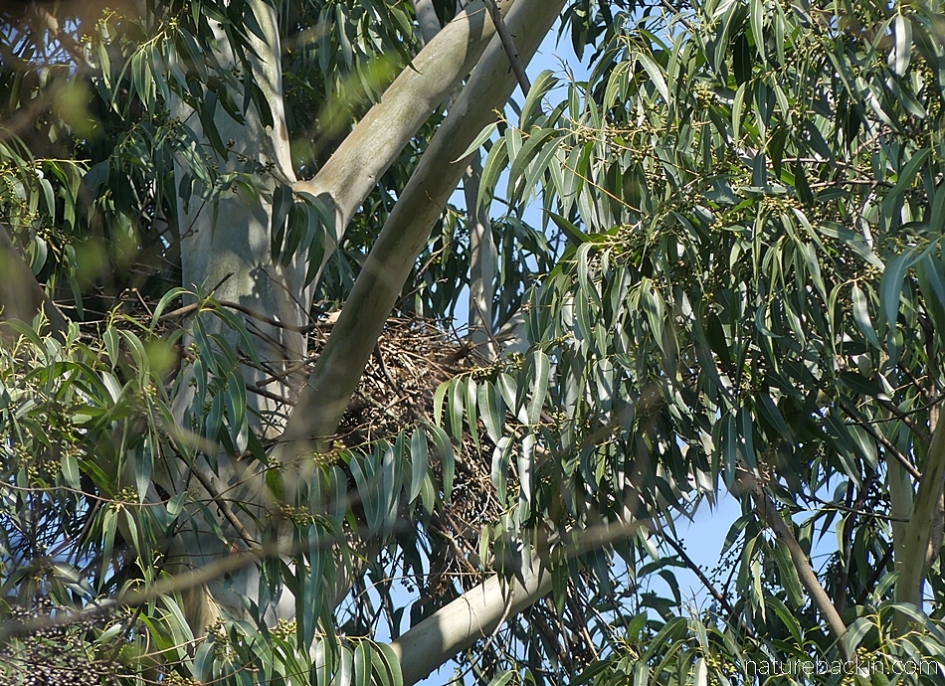
The nest, looking like a heap of sticks in forks of branches against the main trunk, is extremely well hidden, being very high in a tall eucalyptus tree and obscured by foliage
A few days after seeing the chick we realised that something was wrong. There was no calling and we no longer saw the parents at all. Peering at the nest from a distance all was quiet.
During the past weeks we never heard or saw Egyptian geese going anywhere near the nesting tree. The only largish bird to approach the nesting tree that we were aware of was an African harrier-hawk (gymnogene) that we heard calling from the tree, but although they hunt nestlings I can find no mention of them taking from nests prey as large as black sparrowhawks. Although African harrier-hawks may make use of nests made by other raptors, including black sparrowhawks, I have not read that they actively evict occupants of a nest that is in use.
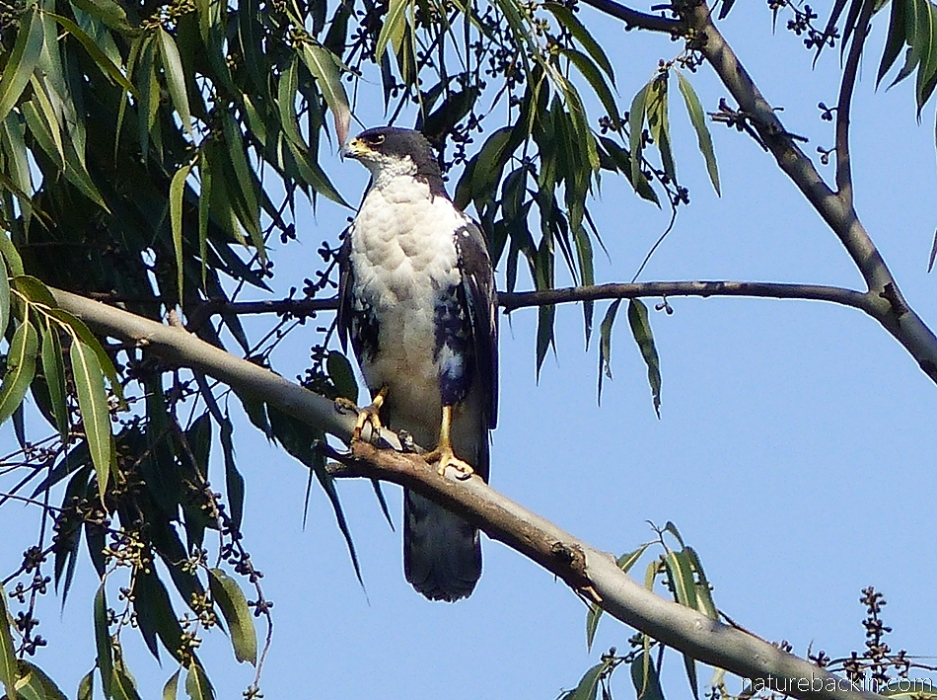
The female black sparrowhawk is larger than the male. The weight range for a female is 820–1040 grams, and the smaller male 505–630 grams
So there is no closure to this story. We have not seen or heard black sparrowhawks or African harrier-hawks in the neighbourhood for at least the past two weeks (although they may be there unnoticed by us), nor have we been aware of any human activities that may have interfered with the birds. As so often is the case in nature, much happens that we humans remain oblivious of.
All I can offer you is some video footage of the pair of black sparrowhawks who nested unsuccessfully in our neighbourhood this year. First is the female in her favourite perching tree followed by rather shaky footage of her calling – she was quite far off being about 90 metres away. Next is a clip of the pair mating in the same tree. When I first saw them mating I got the camera and had it ready to capture what seemed to be their final coupling. Lastly are some clips from our trail camera of a black sparrowhawk drinking from a trough of water we keep filled for wildlife outside our garden and on the margins of the plantation.
We decided to provide this water trough as the stream that used to run in the small valley between us and the plantation prior to the advent of the commercial plantation, no longer runs – probably because the fast-growing eucalyptus plantation trees require so much water.
Sources: Black sparrowhawks of the Cape Peninsula. 2011. https://blackspar1.wordpress.com/; Roberts VII Multimedia Birds of Southern Africa: PC Edition. 1997-2016 Southern African Birding. For details go to http://www.sabirding.co.za/roberts7/portal.html; Foote, Christopher. 2016. Hawk vs. goose: How to cope with an unpleasant neighbour. BMC Series Blog. https://blogs.biomedcentral.com/bmcseriesblog/2016/05/09/hawk-vs-goose-cope-unpleasant-neighbour/; Suri, Jessleena . [2016]. Raptors as urban adaptors? What can Cape Town’s black sparrowhawks tell us about city-dwelling raptors? British Ornithologists Union. https://www.bou.org.uk/suri-urban-raptors/
Posted by Carol

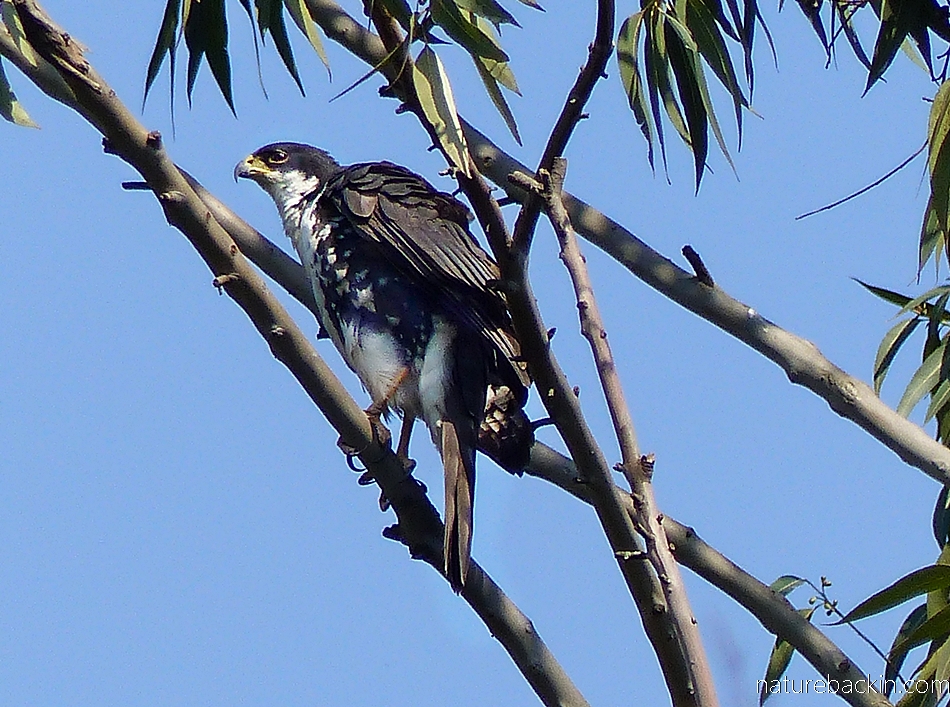







September 20, 2020 at 9:46 pm
It seems you experience some of the same joy and then the dark side of sorrow when things don’t always go as they ought to with the wildlife. I find it difficult not to get attached to some of our creatures and then suffer loss when they disappear for unknown reasons. Still, the joy does seem to outweigh the sadness for the most part. I suspect that the mystery of what might have gone wrong can sometimes linger. I suppose it’s what we humans hope to avoid with “closure”. ??? 🙂
LikeLiked by 1 person
September 23, 2020 at 7:40 pm
Yes, that whole concept of closure isn’t really available when so much is unknown and mysterious to us mere humans who are barely scratching the surface when observing the natural world. The lives of wild animals generally are very precarious. What upsets me most re wildlife is persecution and lack of empathy from humans, and of course the ongoing destruction of habitat and other widespread constraints and threats facing wildlife..
LikeLike
September 15, 2020 at 12:05 pm
Wonderful to be transported back to your backyard this evening. The video with sound is very special. Hoping for a positive outcome in time to come.
LikeLiked by 1 person
September 15, 2020 at 7:34 pm
Thanks Anne. I have seen the female sparrowhawk twice since posting – once in the perching tree and once in the nesting tree. I need to spend some time watching the nest, but we had lovely light rain today, which not only cramped my outdoor activities but also hunting possibilities for the sparrowhawks. Will see what tomorrow brings …
LikeLike
September 12, 2020 at 9:43 am
As usual, so interest 🙂
LikeLiked by 1 person
September 13, 2020 at 7:52 pm
Thanks Edith.
LikeLike
September 11, 2020 at 12:42 pm
It is indeed disappointing that this pairing appears to have lost its chick. Everyone wants a happy ending but as you say, many things may have occurred to have brought this to pass. But the footage and observations you have shared are important in their own right and I appreciate the opportunity to learn more about these birds. That coupling looked quite a feat of agility, perched on the end of the branch as she was! Hopefully now they have built a new nest the pair will return with more success in the future.
LikeLiked by 1 person
September 11, 2020 at 1:46 pm
Thanks Sandra – yes that coupling required extreme agility and not a little strength!
I did see the female sparrowhawk this morning after not having seen them for about 2 weeks, but no activity at the nest, but I will keep an eye out.
I gather that there are records of black sparrowhawks double brooding, which is extremely unusual for large raptors, so perhaps they may be able to relocate although it is late in the season.
LikeLiked by 1 person
September 11, 2020 at 7:44 am
I was distressed to read of the abandoned chick. I know that nature is “red in tooth and claw” but it is agonising when human interference adds to the struggle for existence of birds (and animals). I salute you for saving that nesting tree and wish their had been a happier outcome this year
LikeLiked by 1 person
September 11, 2020 at 1:43 pm
Yes it is distressing. I saw the female sparrowhawk this morning (as already said in some of the previous comments) but no signs that the nest is still a going concern, but I will keep watching and report back if there are any developments.
LikeLiked by 1 person
September 11, 2020 at 5:56 am
How fascinating – and disappointing too, the lack of happy ending – but together with the video this is a great piece of observation.
LikeLiked by 1 person
September 11, 2020 at 1:39 pm
Thanks Margaret. As I commented earlier, I did see the female sparrowhawk this morning in her perching tree so she is still around, so I will be looking out earlier in the morning in case she is still visiting the nest unbeknown to us …
LikeLiked by 1 person
September 11, 2020 at 1:50 pm
Fingers crossed …
LikeLiked by 1 person
September 11, 2020 at 5:31 am
Thanks for documenting this. Such a challenge for wild things to carve out an existence in the human-centric world.
LikeLiked by 1 person
September 11, 2020 at 1:37 pm
Thanks Nikki. Very challenging indeed, although almost paradoxically black sparrowhawks have been able to take advantage of exotic tree plantations.
As I have said in some of the earlier comments, happily I saw the female sparrowhawk this morning, but did not see her near the nest. I will be keeping an eye out at earlier in the mornings over the next few days though …
LikeLike
September 11, 2020 at 4:49 am
What a privilege to see these birds! Thank you for the bonus of a video. Although you are unable to draw a conclusion to this saga, it illustrates an interesting aspect of the behaviour of birds: what makes them behave the way they do? I have become aware that occasionally when all the birds in our garden seem to disappear at once there is a raptor in the vicinity and have learned to scan the sky for one. When there is a cacophony made up by several birds at once this might mean the presence of a snake. All well and good, but they sometimes fly off – or keep away from the garden for days – for no apparent reason. Your keen observations add to my interest in the fascinating world of birds.
LikeLiked by 1 person
September 11, 2020 at 1:31 pm
It is indeed fascinating. I find the more I try to observe the more I start realising how very little I know and how very little I actually do notice or see!
LikeLike
September 11, 2020 at 2:22 pm
I feel the same.
LikeLiked by 1 person
September 11, 2020 at 4:38 am
How cool to have a bird like that in your backyard, or very close anyway. Those geese must be pretty ornery to take them on. Too bad about the chick, but those things are part of nature. Not long ago, the wind toppled a white-eye nest in a tree in the yard, and the two chicks were dumped out and didn’t survive long. There are so many things stacked against them, it’s a wonder anything wild survives.
LikeLiked by 1 person
September 11, 2020 at 1:27 pm
I gather that the geese can’t make nests themselves (just a scrape in the ground in wetland habitats) so to nest in areas such as on the urban edge they more likely have to evict nest-makers. Enough to make anyone ornery I suppose (what a strange word that is!).
Sad to see vulnerable little chicks dumped out like that. Bird parents have to work so hard and struggle against those odds …
LikeLiked by 1 person
September 11, 2020 at 3:08 am
Carol I look forward to reading your posts, they are always so interesting, informative and well illustrated by your beautiful photographs. Although it is sad that the juvenile wasn’t raised to maturity, this happens perhaps more frequently than we realise in the wild. However our impact as humans has also become more invasive. Thank you! xxx
LikeLiked by 1 person
September 11, 2020 at 1:12 pm
Thank Christine. Yes the mortality of nestlings and fledglings is typically high, but in this case it would be interesting to know what happened.
However, I did see the female this morning, so now I am wondering if they are not more silent and discreet and perhaps hunting earlier in the mornings than before. I will try to keep an eye out earlier in the mornings. However, I don’t see them hunting just before dusk either.
LikeLiked by 1 person
September 11, 2020 at 2:46 am
What a fascinating opportunity to observe one of our lesser seen raptors, Carol, and so beautifully depicted in your images and video. I hope that whatever caused the unsuccessful breeding attempt this year don’t deter them from attempting again next year, and at the same nesting site.
LikeLiked by 1 person
September 11, 2020 at 1:08 pm
Well this morning I saw the female preening in her perching tree! She flew off in the opposite direction to her nest.
Incidentally, I found an article this morning that reported on black sparrowhawks double brooding, which is most unusual for large raptors. I can give you the link if you are interested.
LikeLike
September 11, 2020 at 3:07 pm
Good news, Carol, and I’d love to read the article, please.
LikeLiked by 1 person
September 11, 2020 at 8:02 pm
Here is the ref and link to the article:
Curtis, O, et al. 2004. Multiple‐brooding in birds of prey: South African Black Sparrowhawks Accipiter melanoleucus extend the boundaries. IBIS: International Journal of Avian Science. 16 December. https://onlinelibrary.wiley.com/doi/full/10.1111/j.1474-919x.2004.00311.x
LikeLiked by 1 person
September 12, 2020 at 2:12 am
Thanks a lot, Carol!
LikeLiked by 1 person
September 12, 2020 at 2:24 am
Amazed to read about the pair at Eshowe that raised three broods in one year!
LikeLiked by 1 person
September 13, 2020 at 7:51 pm
Yes remarkable. Shame about the green pigeons though!
LikeLike
September 10, 2020 at 11:04 pm
Such a magnificent bird– too bad about the nest failure. Nature can be tough. 😦
LikeLiked by 1 person
September 11, 2020 at 1:02 pm
Yes it is tough. Interestingly though – this morning I saw the female in her favourite perching tree. Once she’s finished preening she flew off but not in the direction of the nest.
LikeLiked by 1 person
September 10, 2020 at 9:38 pm
Happy bird watching
LikeLiked by 1 person
September 11, 2020 at 1:00 pm
Thanks.
LikeLike